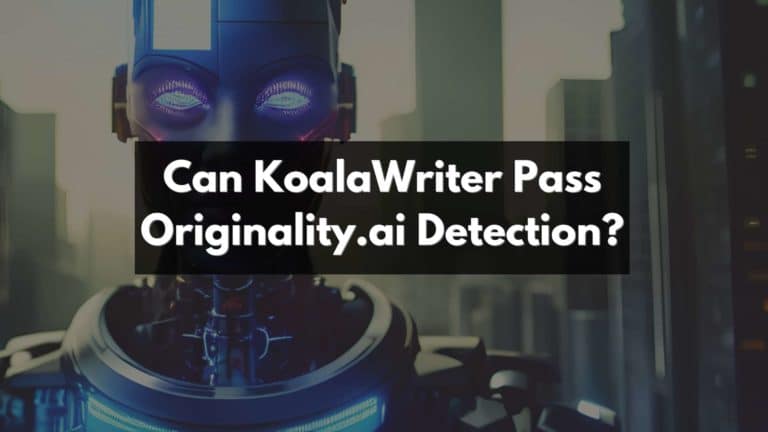Can Copysmith Pass Turnitin Detection?
Are you questioning if Copysmith can fool Turnitin’s AI detection? This common concern is raising eyebrows among writers who are looking into artificial intelligence content generation.
In this article, we will unpack the ins and outs of how Turnitin works and evaluate the potential for Copysmith to elude its detectors. Ready to unravel the truth? Let’s dive in!
Understanding Turnitin’s AI Writing Detection Capabilities
Turnitin’s AI writing detection works by analyzing text similarity and sentence patterns to detect potential plagiarism.
How Turnitin’s AI writing detection works
Turnitin leverages advanced artificial intelligence capabilities to scan and analyze a piece of text for potential plagiarism. The technology dives deep into the sentence structure, language use, and other linguistic patterns, comparing them with millions of academic papers, articles, books in its database.
This process identifies similarities that may indicate instances of copied content. Moreover, Turnitin’s AI system can distinguish between human-written and machine-generated texts by detecting certain characteristics commonly found in AI-crafted work such as consistent tone throughout the document and lack often seen verbosity in human writing style.
Parameters and flags considered in AI writing detection
Turnitin’s AI writing detection system considers various parameters and flags to identify content created by AI tools like Copysmith. These parameters and flags include:
- Text similarity analysis: Turnitin compares the submitted text with a vast database of academic sources, websites, and student papers to identify similarities.
- Sentence structure analysis: Turnitin examines the sentence structure and syntax to detect patterns commonly found in AI-generated content.
- Word choice analysis: Certain words or phrases that are commonly used by AI tools may raise red flags in Turnitin’s detection system.
- Citation analysis: Turnitin analyzes the presence and format of citations to determine the authenticity of the content.
- Plagiarism prevention algorithms: Turnitin uses advanced algorithms to detect plagiarism by comparing the submitted work with previously detected instances of plagiarism.
Accuracy and false positive rate of Turnitin’s AI writing indicator
Turnitin’s AI writing detection system is known for its accuracy and low false positive rate. According to Turnitin, their AI detection system boasts a 98% accuracy in detecting AI-generated content and less than 1% false positives.
This means that it can effectively identify content created by tools like Copysmith. When using Copysmith or similar AI content writers, it is crucial to keep in mind the high level of scrutiny applied by Turnitin’s detection technology.
Avoiding direct copying of information and ensuring originality are key to evading detection and maintaining academic integrity.
Evaluating Copysmith’s Ability to Bypass Turnitin’s AI Writing Detection
In this section, we will assess the effectiveness of Copysmith in evading detection by Turnitin’s AI writing analysis.
Factors to consider in determining the effectiveness of Copysmith in evading detection
Copysmith’s effectiveness in evading detection can be determined by considering the following factors:
- Text similarity analysis: Turnitin’s AI detection system analyzes the similarity between texts to identify potential plagiarism. Assessing how Copysmith handles text similarity can determine its ability to bypass this aspect of detection.
- Sentence structure analysis: The AI writing detection system also examines the structure and syntax of sentences. Evaluating how well Copysmith generates unique sentence structures can indicate its capability to evade detection.
- Paraphrasing techniques: Turnitin detects plagiarism by comparing phrases and sentences to existing content. Examining Copysmith’s paraphrasing abilities and whether it produces content that significantly differs from existing sources is crucial in assessing its evasion potential.
- Originality check: Turnitin places a high emphasis on originality, so evaluating if Copysmith creates original and unique content can determine its likelihood of being detected.
- Citation analysis: Turnitin considers proper citation and referencing as an essential aspect of academic integrity. Assessing whether Copysmith includes accurate citations when generating content can contribute to gauging its evasion prowess.
- Plagiarism prevention techniques: Understanding if Copysmith incorporates advanced measures like anti-plagiarism algorithms or checks during content generation is vital for determining its effectiveness in avoiding detection.
- Content uniqueness metrics: Turnitin uses various algorithms to compare the uniqueness of generated content with existing sources. Evaluating if Copysmith’s output meets these standards is crucial in assessing its detection-avoidance capabilities.
- Avoidance of bot-generated patterns: Recognizing if Copysmith generates content with distinct human-like patterns rather than predictable bot-generated patterns is essential in determining its ability to pass Turnitin’s AI detection.
- Technical sophistication: Considering the level of technical sophistication employed by Copysmith, such as AI models used or machine learning capabilities, can provide insights into its evasion potential.
- Continuous improvement: Determining if Copysmith actively updates its algorithms and features to stay ahead of Turnitin’s detection methods is crucial for assessing its long-term effectiveness in evading detection.
Importance of Using Original and Authentic Content in Academic Writing
Using original and authentic content in academic writing is crucial to maintain academic integrity and avoid any form of plagiarism or copyright infringement.
Why using Copysmith may be considered cheating or unethical
Using Copysmith to generate content for academic writing may be considered cheating or unethical due to several reasons. First, it undermines the principles of academic integrity and originality.
Copying or paraphrasing content created by an AI tool like Copysmith does not reflect the writer’s own thoughts, ideas, or research efforts, which are essential components of academic work.
Secondly, using Copysmith can lead to copyright infringement issues. The generated content may include text that is protected by copyright laws, and using such content without proper attribution or permission can result in legal consequences.
Additionally, relying on AI-generated content diminishes the value of human creativity in copywriting. Writing is a skill that requires critical thinking, analysis, and personal expression.
By depending solely on AI tools like Copysmith, writers miss out on the opportunity to develop their own writing skills and contribute unique perspectives to their work.
Trustworthiness of content created by Copysmith
Copysmith’s trustworthiness in creating content that can pass AI detection is a crucial consideration for writers. While Copysmith utilizes advanced AI technology to generate text, there is a possibility of being detected by systems like Turnitin.
It is important to note that Turnitin’s AI writing detection system analyzes parameters such as text similarity and sentence structure to identify AI-generated content. Therefore, it is essential to prioritize originality and authenticity in academic writing, avoiding the use of tools like Copysmith that may be considered unethical or cheating.
Trustworthy content should uphold academic integrity and ensure content uniqueness while preventing any form of plagiarism or copyright infringement.
Conclusion
In conclusion, while Turnitin’s AI writing detection system is advanced and effective, it is possible to bypass its detection with tools like Copysmith. However, using such methods raises ethical concerns and goes against the principles of academic integrity.
It is always best to create original and authentic content that showcases your own ideas and knowledge.
FAQs
1. Can Copysmith pass Turnitin’s plagiarism detection?
Yes, Copysmith’s generated content can pass Turnitin’s plagiarism detection as it creates unique and original content based on the input provided by the user.
2. Does using Copysmith guarantee that my work won’t be flagged for plagiarism?
While Copysmith generates unique content, it is important to use the tool responsibly and cite any sources used to avoid plagiarism flags. It is always recommended to review and edit the generated content before submission.
3. Is Copysmith considered an ethical tool for academic writing?
Copysmith is a tool designed to assist with content generation and does not promote unethical practices such as plagiarizing or copying others’ work without proper attribution. As long as users adhere to ethical guidelines, it can be used responsibly in academic writing.
4. Will using Copysmith affect my credibility as a writer or student?
Using Copysmith responsibly will not negatively impact your credibility as a writer or student since it helps generate unique ideas and content based on your inputs. Properly citing any sources used will ensure transparency in your work.





